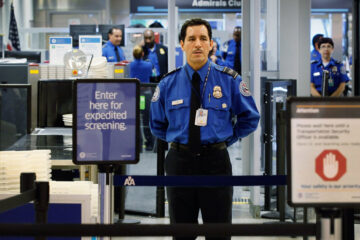It’s been rough going for many businesses since Covid forced many inside and online in 2020, reshaping how consumers shop and spend.
Among the hardest hit have been retailers and banks, which once relied heavily upon face-to-face relationships, making brick-and-mortar locations necessary. Nowadays, however, thanks to technological advances, more people are shopping and banking online, making those physical locations less important.
💵💰Don’t miss the move: Subscribe to TheStreet’s free daily newsletter 💰💵
As a result, many banks are rethinking their footprint, shuttering locations, and reimagining remaining spaces, including the nation’s fourth-largest financial institution.
Major national banks continue to close branch locations.
Justin Sullivan/Getty
Banking is undergoing a massive change
The internet hasn’t just reshaped retail. It’s also enabled a seismic shift in how banks do business.
The ability to deposit and withdraw funds without using a branch teller, borrow money, and pay interest on loans via bank websites and apps has led many banks to merge, go under, or close once popular branches.
Related: Major national bank closing dozens of branches (locations revealed)
The number of U.S. commercial banks declined by almost 50% between 2000 and 2020 as it became easier for large national banks like Bank of America and Wells Fargo to compete against smaller, local rivals.
Bank branches that remain open look very different today than in the past.
Instead of long teller lines and longer waits on payday, most teller stations have been replaced with teller pods staffed by only a few employees, and most paychecks are deposited via direct deposit.
Banks also provide self-service kiosks and other technology within their branches, which allow customers to access online banking rather than dealing with a teller face to face.
The freed-up space left over by removing teller lines has been repurposed to accommodate financial consultations like money management or lending and less on transaction services.
Unsurprisingly, these changes mean banks often need far less space than in the past, causing them to focus on smaller locations or close branches.
The economy created a headwind for banks
It didn’t help banks that the Federal Reserve embraced hawkish monetary policy to battle runaway inflation in 2022.
Related: Massive big-box retail chain closing locations (here’s the list)
The decision by the Fed to rapidly increase the Fed Funds Rate to tamp down economic activity to slow inflation not only dented loan demand but also sent the value of Treasury Bonds held on bank balance sheets reeling.
The risk of having to mark-to-market bond portfolios at significantly lower valuations resulted in the failure of Silicon Valley Bank (SVB) on March 10, 2023, amid the largest one-day bank run in U.S. history, according to Brookings Institution.
Two days later, Signature Bank failed because of similar concerns. Then, on May 1, 2023, First Republic Bank failed, prompting a last-minute acquisition by JP Morgan Chase.
Banks have adjusted the composition of bonds on balance sheets since then, but additional challenges have emerged.
Housing prices remain elevated and combined with high mortgage rates, mortgage loan demand has been depressed. The industry has also seen similar headwinds in auto lending and, more recently, upticks in credit card delinquencies and defaults because of cash-strapped borrowers.
Wells Fargo to close over a dozen branches
The big national banks aren’t unscathed by banking industry trends, and major players, including Wells Fargo, are also reconsidering their plans for brick-and-mortar branches.
Wells Fargo is the nation’s fourth biggest bank, with assets of about $1.7 trillion. The bank operates over 4,000 branches in 36 states, with a large presence in California, Texas, and Florida.
The company, once a Wall Street darling, has struggled with controversy.
In 2020, it agreed to a $3 billion fine for a scandal resulting from unrealistic sales goals that pressured employees to open fake accounts in customers’ names between 2002 and 2016. The reputational backlash led many long-time investors, including billionaire investor Warren Buffett, to shun owning Wells Fargo stock.
Buffett’s Berkshire Hathaway owned about 500 million shares in Wells Fargo in 2016, representing roughly 10% of the company. However, following the scandal, the Oracle of Omaha has since sold his stake, eliminating the last of his shares in 2022.
CEO Charlie Scharf has been working to restore confidence, jettisoning businesses, shifting revenue toward fees, and cutting expenses, including the size of its workforce.
“Overall, expenses declined from a year ago, benefiting from lower FDIC and severance expenses as well as the impact of our efficiency initiatives, which have helped drive headcount reductions every quarter since third quarter of 2020,” said Scharf on the company’s fourth-quarter earnings conference call.
The company closed 92 branches last year, and despite declining average loans, Wells Fargo reported net income of $18.6 billion or $5.43 per share in 2024.
The profit tailwinds suggest the bank will not shy away from its strategy, and unsurprisingly, that means more of its branch locations will disappear in 2025.
Wells Fargo has filed documents with the Office of the Comptroller of the Currency (OCC) indicating the following 14 branches are closed or will soon be closed:
321 University Drive, College Station, Texas100 Nile Kinnick Dr, N. Adel, Iowa1930 North Loop 1604 E, San Antonio, Texas7928 Fort Hunt Road, Alexandria, Virginia3901 E. Grant Rd, Tucson, Arizona225 108th Avenue N.E., Bellevue, Washington7801 Falls of Neuse Rd, Raleigh, North Carolina1600 Montgomery Highway, Hoover, Alabama590 Hunt Club Boulevard, Apopka, Florida652 N. La Brea Avenue, Los Angeles, CaliforniaOne Main Street, George, Utah2611 Cedar Springs Road, Dallas, Texas687 S. Coast Highway 101, Suite 151, Encinitas, California25100 F.M. 2100, Huffman, Texas.
Related: Veteran fund manager unveils eye-popping S&P 500 forecast


